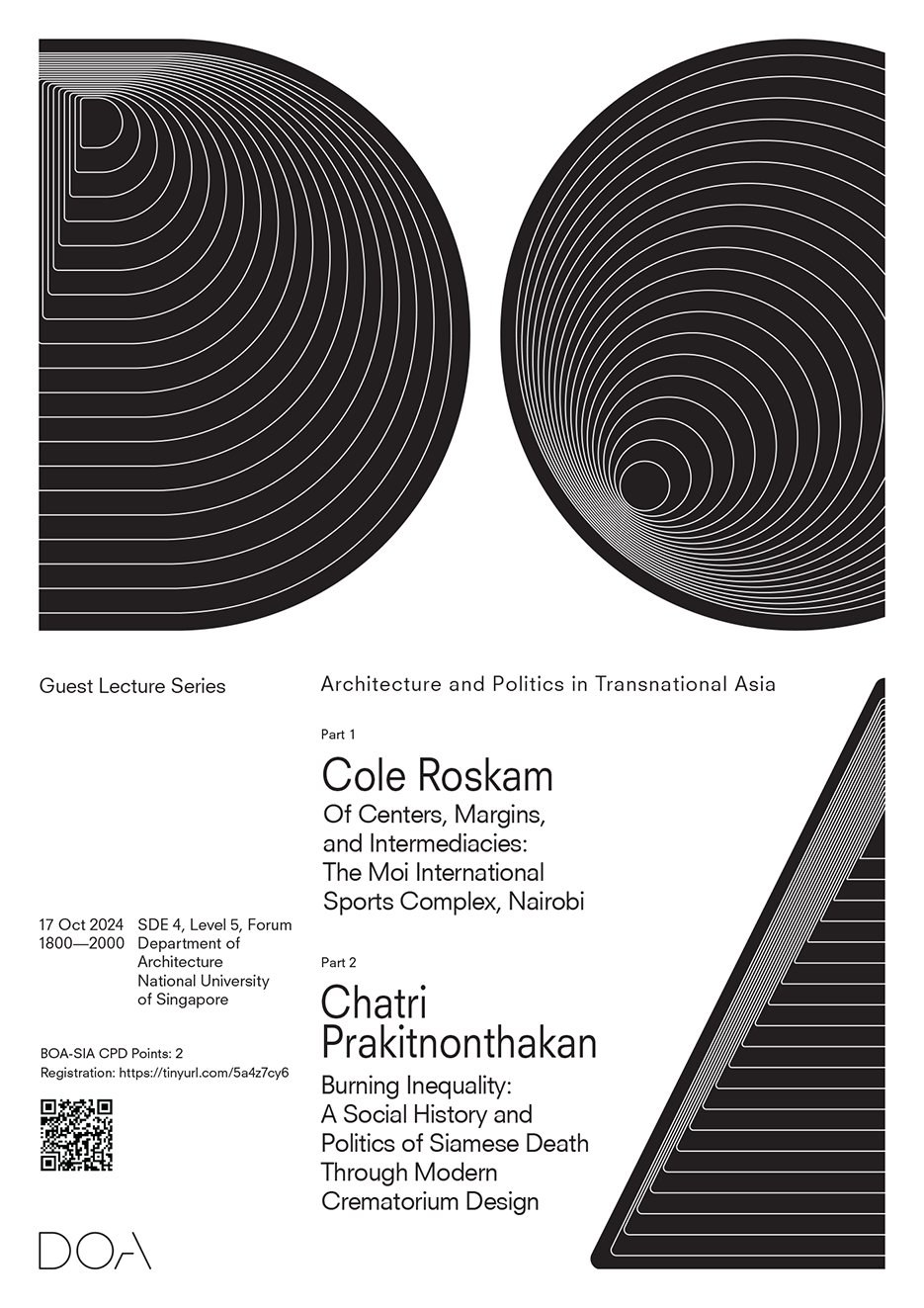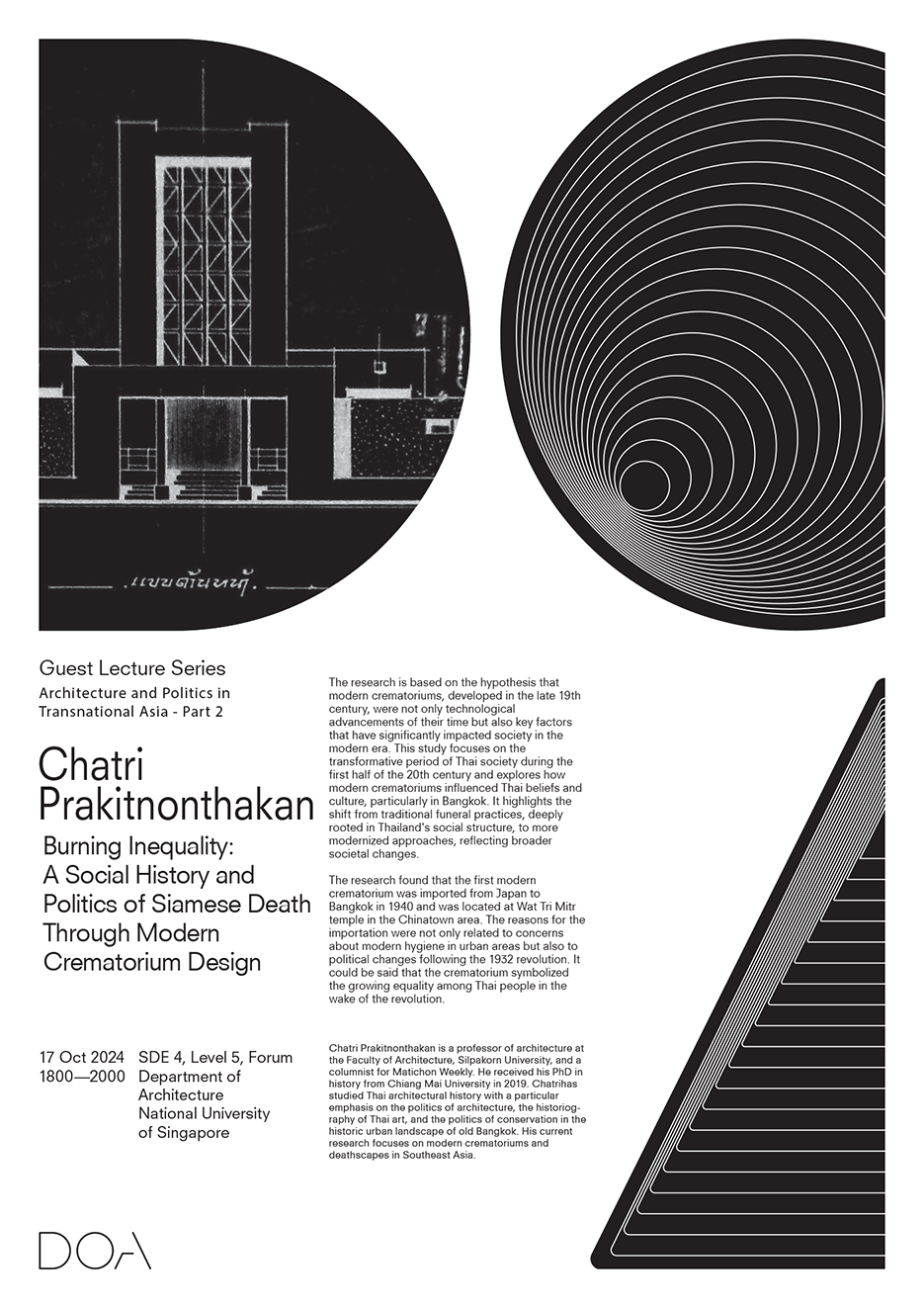Architecture and Politics in Transnational Asia
Name of Event/Lecture
Architecture and Politics in Transnational Asia
Name of Speaker
Cole Roskam and Chatri Prakitnonthakan
Location
SDE 4, Level 5, Forum

You are cordially invited to attend the guest lectures by Cole Roskam and Chatri Prakitnonthakan:
Date: 17 October 2024
Time: 6-8pm
Venue: SDE 4, Level 5, Forum
BOA-SIA CPD Accreditation Points: 2
Please register your interest here: https://tinyurl.com/5a4z7cy6

Lecture 1:
Of Centers, Margins, and Intermediacies: the Moi International Sports Complex, Nairobi
By Cole Roskam
The Moi International Sports Center was designed and built between 1982 and 1987 by Chinese architects and engineers in Nairobi, the capital and largest city in Kenya. It offers a useful case study through which an architectural history of Afro-Asia interactivity may be considered, particularly in relation to organized athletics and the buildings and infrastructure to them – stadiums, sports complexes, and associated supporting roads and utility systems.
The People’s Republic of China (PRC) has long recognized the multivalent significance of these spaces, which have been described as integral parts of a modern society’s everyday life. On one hand, social performances enabled by massive physical sites demonstrate a society’s capacity to coordinate and control relatively spontaneous conditions. At the same time, these events are expensive, logistical challenges that require significant financing, sophisticated design expertise, and reliable management systems over time. In this lecture, I will trace the PRC’s emphatic financial-, design-, and construction-related support for such facilities in specific relation to Kenya, underscoring not only the sports center’s distinctive physical and social qualities, but the diplomatic and political rhetoric attached to its value. At the same time, the Moi International Sports Center also offers insight into Africa and China’s entwined conditions and modern aspirations, particularly with regards to the new analytical methods required to account for a stadium’s symbolic and practical significance as both a distinctive building type and a contributing force to a country’s politics, economy, society, and culture.
About the speaker
Cole Roskam is professor of architectural history in the Department of Architecture at the University of Hong Kong. His research explores architecture’s role in mediating moments of interaction and exchange between China and other parts of the world. He is the author of Improvised City: Architecture and Governance in Shanghai, 1843-1937 (University of Washington Press, 2019) and Designing Reform: Architecture in the People’s Republic of China, 1970-1992 (Yale University Press, 2021). His writing has appeared in AD, Architectural History, Artforum International, Grey Room, and the Journal of the Society of Architectural Historians, among others. He has been a fellow at the Center for Advanced Study in the Visual Arts (Washington, DC), the Canadian Centre for Architecture (Montreal), and the University of Edinburgh.

Lecture 2 :
Burning Inequality: A Social History and Politics of Siamese Death Through Modern Crematorium Design
By Chatri Prakitnonthakan
The research is based on the hypothesis that modern crematoriums, developed in the late 19th century, were not only technological advancements of their time but also key factors that have significantly impacted society in the modern era. This study focuses on the transformative period of Thai society during the first half of the 20th century and explores how modern crematoriums influenced Thai beliefs and culture, particularly in Bangkok. It highlights the shift from traditional funeral practices, deeply rooted in Thailand’s social structure, to more modernized approaches, reflecting broader societal changes. The research found that the first modern crematorium was imported from Japan to Bangkok in 1940 and was located at Wat Tri Mitr temple in the Chinatown area. The reasons for the importation were not only related to concerns about modern hygiene in urban areas but also to political changes following the 1932 revolution. It could be said that the crematorium symbolized the growing equality among Thai people in the wake of the revolution.
About the speaker
Chatri Prakitnonthakan is a professor of architecture at the Faculty of Architecture, Silpakorn University, and a columnist for Matichon Weekly. He received his PhD in history from Chiang Mai University in 2019. Chatrihas studied Thai architectural history with a particular emphasis on the politics of architecture, the historiography of Thai art, and the politics of conservation in the historic urban landscape of old Bangkok. His current research focuses on modern crematoriums and deathscapes in Southeast Asia.